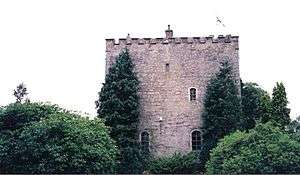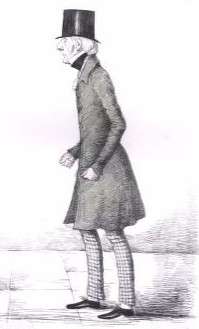James Menteath
James Menteath, in later life James Stuart Menteath of Closeburn (c.1718–1802) was a Scottish clergyman of the Church of England, and friend of Adam Smith.[1][2]
Early life
Born at Burrowine, Perthshire (now in Fifeshire) around 1718, he was son of William Menteath of Burrowine. He matriculated at the University of Glasgow in 1732. He then matriculated at Balliol College, Oxford on 9 April 1736, graduating B.A. 1739, M.A. 1742. He was supported there from 1736 by a Snell Exhibition, which he vacated in 1747.[1][3]
Parish priest in England
Menteath took holy orders in the Church of England, being ordained deacon in 1740, priest in 1741.[4] He shortly became a curate at Adderbury in Oxfordshire, where John Cox was vicar.[5] He was rector at Bishop's Cleeve, from 1754.[4] He then moved on, as rector of All Saints Church, Barrowby in Lincolnshire, in 1759. He owed the Barrowby living to Sackville Tufton, 8th Earl of Thanet.[6]
Sanderson Miller of Radway in Warwickshire cultivated a number of clerical friends with Oxford educations, including Richard Jago and William Talbot of Kineton, as well as Menteath.[7] A statue of Caractacus by James Lovell was commissioned by Lord North as a gift to Miller, for his tower on Edge Hill; it was modelled from Menteath.[8] After a number of breakdowns, Miller was put into the hands of Francis Willis for treatment for his mental illness. While under Willis, he wrote a digressive Memoir of Menteath, dated from internal evidence to the years 1772–4.[9]
Menteath appears in Miller's Memoir as "Jacobus Montaltus", a Latinised version of his name. Annotations by Menteath state that he and Miller were close friends, from 1737 (when they overlapped at the University of Oxford, at St Mary Hall) to 1780 when Miller died.[10] The Memoir states that Menteath was promised the Barrowby living from 1745, by Sackville Tufton, 7th Earl of Thanet and his wife; the incumbent was Thomas Wood, who held it from 1732 to 1759. This was also the year of the Jacobite Rebellion, in which Menteath became embroiled, on a visit to his family.[11]
In 1770 Menteath assumed the additional surname of Stuart "for himself and his posterity."[1][12]
Later life

In 1783 Menteath purchased Closeburn Castle in Dumfriesshire, from Sir Thomas Kirkpatrick.[13][14] On his moving north in 1785, Adam Smith wrote to Menteath describing him as his oldest friend, outside his extended family.[12] They knew each other from Kirkcaldy, in Fifeshire and Smith's home in early life.[15]
Menteath died 15 July 1802.[16]
Family

Menteath married, 15 April 1765, Catherine Maria (died 14 August 1793) daughter of the Rev. Granville Wheler, of Otterden Place, Kent, by his wife Lady Catherine Maria Hastings, daughter of Theophilus Hastings, 7th Earl of Huntingdon. Their son Charles Granville Stuart Menteath of Closeburn and Mansfield, born 12 May 1769, was created Baronet on 11 August 1838, and died 3 December 1847.[1][17] He is also known as Sir Charles Granvill Stuart-Menteth, 1st Baronet. His eldest son became Sir James Stuart-Menteth, 2nd Baronet.[1] The Closeburn estate passed out of the family in 1852.[18]
Notes
- 1 2 3 4 5 Addison, W. Innes (1901). "The Snell Exhibition, from the University of Glasgow to Balliol College, Oxford". Internet Archive. Glasgow: MacLehose. pp. 41–2. Retrieved 29 February 2016.
- ↑ Ross, Ian Simpson (2010). The Life of Adam Smith (2nd ed.). Oxford University Press. p. 399. ISBN 9780199550036.
- ↑ Addison, W. Innes (1913). "The Matriculation Albums of the University of Glasgow From 1728–1858". Glasgow: James Maclehose and Sons. p. 31. Retrieved 29 February 2016.
- 1 2 "CCED: Person Display Menteath, James Stuart (1740–1802)". Retrieved 1 March 2016.
- ↑ Sanderson Miller; William Hawkes; Dugdale Society (2005). The diaries of Sanderson Miller of Radway, together with his memoir of James Menteath. Dugdale Society in association with the Shakespeare Birthplace Trust. p. 342 note 5. ISBN 978-0-85220-084-1.
- ↑ Sanderson Miller; William Hawkes; Dugdale Society (2005). The diaries of Sanderson Miller of Radway, together with his memoir of James Menteath. Dugdale Society in association with the Shakespeare Birthplace Trust. pp. 3, 15, 350n. ISBN 978-0-85220-084-1.
- ↑ Sanderson Miller; William Hawkes; Dugdale Society (2005). The diaries of Sanderson Miller of Radway, together with his memoir of James Menteath. Dugdale Society in association with the Shakespeare Birthplace Trust. p. 15. ISBN 978-0-85220-084-1.
- ↑ Sanderson Miller; William Hawkes; Dugdale Society (2005). The diaries of Sanderson Miller of Radway, together with his memoir of James Menteath. Dugdale Society in association with the Shakespeare Birthplace Trust. pp. 26, 335 note 3. ISBN 978-0-85220-084-1.
- ↑ Sanderson Miller; William Hawkes; Dugdale Society (2005). The diaries of Sanderson Miller of Radway, together with his memoir of James Menteath. Dugdale Society in association with the Shakespeare Birthplace Trust. p. 4. ISBN 978-0-85220-084-1.
- ↑ Sanderson Miller; William Hawkes; Dugdale Society (2005). The diaries of Sanderson Miller of Radway, together with his memoir of James Menteath. Dugdale Society in association with the Shakespeare Birthplace Trust. pp. 4, 328 note 1, 329. ISBN 978-0-85220-084-1.
- ↑ Sanderson Miller; William Hawkes; Dugdale Society (2005). The diaries of Sanderson Miller of Radway, together with his memoir of James Menteath. Dugdale Society in association with the Shakespeare Birthplace Trust. pp. 350 and note 4, 351. ISBN 978-0-85220-084-1.
- 1 2 Vivienne Brown; Samuel Fleischacker (4 October 2010). Essays on the Philosophy of Adam Smith: The Adam Smith Review, Volume 5: Essays Commemorating the 250th Anniversary of the Theory of Moral Sentiments. Routledge. pp. 260–. ISBN 978-1-136-93251-9.
- ↑ Notes and Queries. Oxford University Press. 1869. p. 281.
- ↑ "Robert Burns Country: The Burns Encyclopedia: Menteath, The Rev James Stuart (d. 1802)". Retrieved 29 February 2016.
- ↑ Nicholas Phillipson (2011). Adam Smith: An Enlightened Life. Penguin Books Limited. p. 267. ISBN 978-0-14-028728-8.
- ↑ John Bernard Burke (1845). A Genealogical and Heraldic Dictionary of the Peerage and Baronetage of the British Empire. H. Colburn. p. 675.
- ↑ Charles R. Dadd (1846). The Peerage, Baronetage, and Knightage, of Great Britain and Ireland. p. 274.
- ↑ Francis Hindes Groome (1882). Ordnance Gazetteer of Scotland: A Survey of Scottish Topography, Statistical, Biographical and Historical. T. C. Jack. p. 267.
External links
- "University of Glasgow :: Manuscripts Catalogue :: Material relating to James Stuart Menteath". Retrieved 29 February 2016.
- Attribution
![]() This article incorporates text from a work in the public domain: W. Innes Addison, The Snell Exhibition, from the University of Glasgow to Balliol College, Oxford, 1901
This article incorporates text from a work in the public domain: W. Innes Addison, The Snell Exhibition, from the University of Glasgow to Balliol College, Oxford, 1901